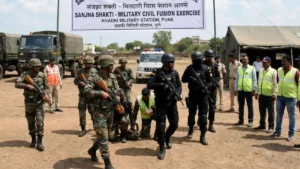The bilateral air exercise “Udara Shakti 2024” between the Indian Air Force (IAF) and the Royal Malaysian Air Force (RMAF) concluded successfully on August 9, 2024. This exercise, hosted by the RMAF at its base in Kuantan, Malaysia, marked a significant milestone in military cooperation between the two nations.
Participation and Return
Indian Air Force Contingent
The IAF’s participation in Exercise Udara Shakti 2024 was notable, with a contingent of seven Sukhoi-30 MKI fighter aircraft. These advanced jets, along with their crews, returned to India on August 10, 2024, after four days of intensive joint exercises and knowledge exchange.
Opening Ceremony
The exercise’s opening ceremony was attended by several dignitaries, including:
- Group Captain Ajay Rathi, the Indian Air Force Team leader
- Ms. Subhashini Narayanan, Deputy High Commissioner of India to Malaysia
- Senior officers from the Royal Malaysian Air Force
Their presence underscored the diplomatic and strategic importance of this bilateral exercise.
Aircraft Deployed: The Sukhoi-30 Connection
Shared Platform
Both the IAF and RMAF deployed seven Sukhoi-30 (SU-30) fighter planes each for Exercise Udara Shakti 2024. This shared platform highlights the common ground between the two air forces and facilitates seamless joint operations.
Origin and Production
The Sukhoi-30 fighters used by both nations have their origins in Russia. However, there’s a key difference in their acquisition:
- Malaysia purchased their SU-30s directly from Russia
- India has largely produced its SU-30MKI variant domestically
India’s SU-30MKI Production
The majority of the IAF’s Sukhoi-30 fleet has been produced in India by Hindustan Aeronautics Limited (HAL) under license from Russia. This domestic production has allowed India to become one of the largest operators of Sukhoi Su-30 fighter jets globally, second only to Russia.
The Indian Variant
India’s version of the Sukhoi Su-30 is designated as the Su-30MKI (Modernizirovannyy Kommercheskiy Indiyskiy), which translates to “Modernised Commercial for India.” This variant incorporates India-specific modifications and enhancements.
Exercise Components and Objectives
Exercise Udara Shakti 2024 was structured around two main components:
- Training Exercises
- Subject Matter Expert Exchange
Training Exercises
The training exercises focused on air combat scenarios, allowing pilots from both nations to engage in simulated aerial warfare using their Su-30 aircraft. These exercises helped improve tactical skills, coordination, and interoperability between the two air forces.
Subject Matter Expert Exchange
This component facilitated the sharing of:
- Expertise
- Insights
- Skills
The exchange covered various aspects of aviation and engineering, with a particular focus on the Sukhoi-30 aircraft. This knowledge-sharing helps both forces optimize their use of the SU-30 platform.
The HOP Exercise: A Unique Feature
One of the most intriguing aspects of Exercise Udara Shakti 2024 was the HOP Exercise. This innovative component involved pilots from both air forces exchanging aircraft:
- Indian pilots flew Malaysian Su-30s
- Malaysian pilots flew Indian SU-30MKIs
Objectives of the HOP Exercise
The HOP Exercise served several crucial purposes:
- Aircraft Evaluation: Pilots could directly compare the performance and handling characteristics of each country’s SU-30 variant.
- Tactical Exchange: It provided an opportunity for pilots to share and discuss combat tactics developed for the same basic aircraft platform.
- Equipment Comparison: Pilots could explore and evaluate differences in avionics, weapons systems, and other equipment between the two SU-30 variants.
- Enhancing Interoperability: By familiarizing pilots with each other’s aircraft, the exercise improved the potential for joint operations in the future.




 DRDO Successfully Tests Indigenous MPATG...
DRDO Successfully Tests Indigenous MPATG...
 Mumbai Marks Tri-Services Veterans Day w...
Mumbai Marks Tri-Services Veterans Day w...
 Exercise ‘Sanjha Shakti’ Held at Dighi H...
Exercise ‘Sanjha Shakti’ Held at Dighi H...







